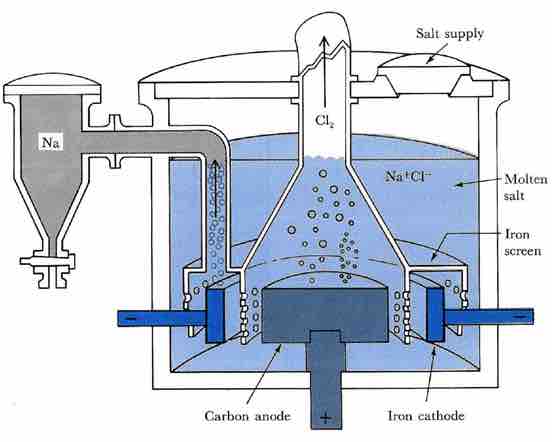Electrolysis of NaCl
As we have covered, electrolysis is the passage of a direct electric current through an ionic substance that is either molten or dissolved in a suitable solvent. This results in chemical reactions at the electrodes and the separation of materials. Two commonly used methods of electrolysis involve molten sodium chloride and aqueous sodium chloride. You might think that both methods would give you the same products, but this not the case. Let's go through each of the methods to understand the different processes.
Electrolysis of Molten NaCl
If sodium chloride is melted (above 801 °C), two electrodes are inserted into the melt, and an electric current is passed through the molten salt, then chemical reactions take place at the electrodes.

Electrolysis cell for molten sodium chloride
A commercial electrolysis cell for the production of metallic sodium and chlorine gas from molten NaCl. Liquid sodium floats to the top of the melt above the cathode and is drained off into a storage tank. Chlorine gas bubbles out of the melt above the anode.
Sodium ions migrate to the cathode, where electrons enter the melt and are reduced to sodium metal:
Chloride ions migrate the other way, toward the anode. They give up their electrons to the anode and are oxidized to chlorine gas:
The overall reaction is the breakdown of sodium chloride into its elements:
Electrolysis of Aqueous NaCl
What happens when we have an aqueous solution of sodium chloride? Well, we can't forget that we have to factor water into the equation. Since water can be both oxidized and reduced, it competes with the dissolved Na+ and Cl- ions. Rather than producing sodium, hydrogen is produced.

Electrolysis of aqueous sodium chloride
Electrolysis of aqueous NaCl results in hydrogen and chloride gas. At the anode (A), chloride (Cl-) is oxidized to chlorine. The ion-selective membrane (B) allows the counterion Na+ to freely flow across, but prevents anions such as hydroxide (OH-) and chloride from diffusing across. At the cathode (C), water is reduced to hydroxide and hydrogen gas. The net process is the electrolysis of an aqueous solution of NaCl into industrially useful products sodium hydroxide (NaOH) and chlorine gas.
The reaction at the cathode is:
The reaction at the anode is:
The overall reaction is as follows:
Reduction of Na+ (E° = –2.7 v) is energetically more difficult than the reduction of water (–1.23 v), so in aqueous solution, the latter will prevail.